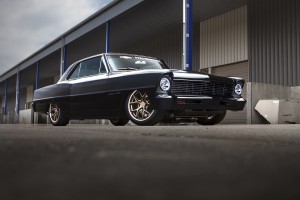
Chevy put a new turbocharged 2.0-liter four cylinder under the hood putting out the same power as the original 327 in this '67 Nova.
Carmakers traditionally reach deep into their bag of tricks every year for the Specialty Equipment Manufacturers Association’s annual show in Las Vegas.
For this year, Chevrolet is demonstrating how it can blend both the old and then new to create a unique custom vehicle. The goal was to demonstrate both the evolution of high-performance and the latest in crate-engine technology by dropping a modern turbocharged engine into the body of a 1967 Chevrolet Nova.
The result is Chevrolet’s turbocharged 1967 Nova 2.0 is a contemporary hot rod.
Chevrolet Performance engineers designed the car to showcase the “LTG” direct-injected 2.0-liter turbo crate engine as an alternative to conventional V-8 conversions. Rated at 272 horsepower, the 2.0-liter engine delivers comparable power to the 275-hp 327 cubic inch from the 5.3-liter V-8 originally offered in the ’67 Nova SS – and more than the 195-hp 283 cubic-inch or 4.6 cubic V-8 also offered in the Chevy II Nova lineup.
With a curb weight of approximately 3,100 pounds, the 327-powered Nova SS was praised in its day for a strong power-to-weight ratio, which helped make it one of the industry’s quicker muscle cars.
(Chevy accents performance with specialty Camaros at SEMA. For more, Click Here.)
That performance advantage is amplified in the Chevrolet Performance concept, as the all-iron V-8 has been replaced with an all-aluminum turbo-four, for a more enviable 50/50 front-to-rear weight distribution. And in place of the original four-speed transmission is a modern six-speed manual.
The modern, lightweight powertrain helps the Nova 2.0 sprint from zero to 60 mph in 6.2 seconds.
(Click Here for details about the new GM-UAW contract.)
The LTG crate engine, the electronic control unit, the engine accessory-drive system and even the six-speed manual transmission – and requisite installation kit – can be ordered now from the Chevrolet Performance.
The Black and Gold Nova 2.0 is also equipped with special touches, such as a billet aluminum grille, narrowed and tucked bumpers, shaved door handles with electronic latch releases, custom 17-inch Z/28-style wheels – in a satin bronze finish – and four-wheel disc brakes.
(To see more about Chevy’s high-performance aftermarket components, Click Here.)
The suspension also was completely updated with height-adjustable air bags, front and rear, and a triangulated four-link design in the rear.

I Wish that I could Find A 283. The Best Eagin, Everrrrr. Please bring it BACKKKKKKKKKKKKK. Thank You.
You can bet the 2.0L turbo doesn’t have the off idle torque of the original 327 or the driving experience. Put a six speed trans behind the 327 and run some zero to sixty times. The latest 2.0L turbo engines are very good engines but most people would not chose them over a low revving V-8 engine for drivability.
Agreed. That 2.0L turbo can be peaky. It may have similar horsepower number (actual may be slightly higher considering gross vs. net) but it is torque that gets you out the hole.
I’m pretty sure this package is hella expensive and doesn’t just “drop-in” into a ’62 – ’67 Chevy II. A lot more room in the ’68 – up Chevy II / Nova, except the Sprint-based version.
283 was a decent, tough little engine, considering it was the workhorse until the 350 debuted. But think of it this way:
4.8L ~ 283ci
5.3L ~ 327ci (actually close b/c it’s 325ci)
5.7L ~ 350ci even though it was 346ci
6.2L ~ “383”, I know not a factory Chevy displacement but they offer it as a crate
7.0L ~ 427 even though it is 427.6ci